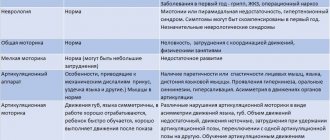Definition
Phonemic awareness is the ability to distinguish, analyze and differentiate heard phonemes - this is phonemic awareness. The baby's sound analyzer is turned on immediately after birth.
He listens to voices and reacts to them. After 6-7 months, he imitates the conversations of adults, copying syllables and individual sounds. By 12 months - says the first word.
In this way, acoustic images of individual phonemes are formed. Children can mix and replace them, this is considered the norm until a certain age. By the age of 4, the child should have a good grasp of the technique of pronunciation of most sounds of his native language. The only exception is -. If this does not happen, then we can talk about dyslalia - phonemic hearing impairment. It is important that incorrect pronunciation does not become a habit; the child must learn to control the clarity of speech, listen carefully to others and to himself.
Classification of hearing loss
- I degree:
usually the child hears well, but problems begin when he finds himself in a noisy acoustic situation. - Stage II:
There are problems with whispered speech, even if it is heard in a quiet environment. - Grade III:
The child has serious problems understanding speech, even if it is quite loud. - IV degree:
the baby hears only what sounds very close to his ear.
The only thing worse than fourth degree hearing loss is complete deafness.
Please note: hearing loss is not a temporary quantitative decrease in the ability to perceive sounds, but qualitative irreversible changes in the entire auditory system, which will inevitably have an impact on the development of the child’s psyche. The role of hearing in human development is very great.
How it manifests itself
Mixing sounds and substitutions provoke dyslalia. Its presence can be determined by the following signs:
- Violation of sound pronunciation. Substitution of sound, for example, voiced sounds are perceived and pronounced as voiceless, hard sounds as soft.
- Omitting consonants and vowel phonemes in words, rearranging them, adding extra sounds. For example, sLobodny, instead of svobodny, dereLa instead of tree, etc.
- Weak differentiation of similar phonemes, their replacement in oral and written speech. For example, mixing and replacing s, z, w - rat instead of roof, bough instead of beetle.
Impaired phonemic hearing in children leads to errors in grammar. The most common spelling errors are unstressed vowels, double consonants, and unvoiced words at the end of a word. The student simply does not hear the impact sound. For him it is similar to an unstressed word, so it is difficult for him to select a test word. At school, such children fail not because of mental retardation or poorly developed intelligence, but because of impaired phonemic hearing.
Features of mental development of children with hearing impairments
The mental development of a child is characterized by the development of his attention, memory and thinking. According to the results of numerous studies, hearing-impaired children experience difficulties in the development of all these indicators.
Features of attention
Children with hearing impairment simultaneously perceive a much smaller number of elements than children with normal hearing. This is especially evident in lessons, when it is necessary, for example, to listen to the teacher and write in a notebook at the same time. It also takes a hearing-impaired child much longer to switch from one type of perception to another, for example, from reading to listening.
Memory Features
Children with normal hearing involuntarily remember a huge number of things through simple contact with the outside world. In a hearing-impaired child, as we remember, such contacts are quite limited, so he remembers much less, although he is capable of the same volumes as a healthy child. Children with hearing impairments are good at remembering words that are closely related to visual images, and things are much worse with words denoting sound or abstract phenomena.
Features of thinking
Due to limited contacts with the world and society, the set of mental tools of a child with hearing loss is not so wide. He often tries to open different doors with one key. A child may have difficulty identifying main and minor details in stories or drawings, or identifying non-obvious cause-and-effect relationships. In general, the development of thought processes will be significantly slowed down.
Teaching children with hearing loss is a challenging task. Both parents and specialists should be involved in solving it in parallel.
Causes
The central and peripheral nervous systems are responsible for speech hearing. The negative impact on them is the impetus for acoustic dysfunctions. The main causes of the disease can be:
- Weakening of the body at any age, especially early
- Infectious diseases
- Digestive problems
Lack of vitamins and minerals leads to lethargy, isolation, and apathy. Attention, level of concentration, memory weakens.
- Thyroid diseases
Hypothyroidism is especially dangerous at an early age, in newborns. Lack of hormones or their abundance have a strong impact on brain processes and mental development.
- Hyperactivity
It is difficult for the child to concentrate; he does not listen to the conversations of adults or their speech. Captures phonemes fragmentarily and also reproduces them.
- Hearing loss
- Injuries to the head, speech and hearing organs
- Unfavorable social environment
- Negative example
The parents have obvious, advanced speech defects that were not corrected in childhood.
Regardless of the causes of phonemic hearing impairment, you should contact a speech therapist, laryngologist, or neurologist as early as possible. Only a special examination and identification of the causes of the disease will help make a diagnosis and correct defects in a timely manner.
Preventing hearing problems in children
With sensorineural hearing loss (chronic), lost hearing cannot be restored, but it is possible to stop the progression of the disease and stabilize the level of hearing at a certain level. If your child begins to have difficulty hearing, immediately contact the KIT multidisciplinary medical center. We will examine the condition of the eardrum, take an X-ray of the temporal bones, make an accurate diagnosis and prescribe treatment.
For preventive purposes, we recommend doing the following:
- Monitor your child regularly, and if you notice signs of hearing impairment, immediately contact your pediatrician, who will refer you to an audiologist and neurologist (if damage to the auditory nerve is suspected).
- Do not self-medicate influenza, ARVI, or other infectious diseases.
- Minimize the risk of your baby receiving acoustic injuries by avoiding places with loud, sharp sounds.
- Teach your child to take care of his ears, not to poke small objects into them, not to clean them with cotton swabs or sharp objects, and to monitor the hygiene of the ear canals and shells.
Diagnostics
It is important to conduct phonemic hearing assessments in preschoolers before entering first grade. They are done by a speech therapist, a speech therapist and parents. Diagnostic techniques were developed by G.A. Kashe, T.B. Filicheva, G.V. Chirkina . Surveys are successfully used in schools, kindergartens, and at the PMC commission.
A specialist working with children uses the following methods to diagnose acoustics and speech defects:
- Determining the sound source (non-speech)
The subject is asked to listen to a musical instrument with his eyes closed, and then say what sound it made. Tambourines, rattles, drums, and bells are used.
- Distinguishing phonemically similar words
Exercise “Attentive ears”.
In front of the subject are pictures depicting objects familiar to him. These are fruits, animals, toys, etc. An adult pronounces a group of words that are phonetically similar to each other, one of them names a drawn object. The subject must pick up the picture when he hears the correct name of the picture.
For example, in the picture there is a pear. An adult slowly pronounces: gruf, glyusya, pear, glusa, etc.
Any raising of a picture without an exact name is considered an error.
Another option for conducting diagnostics using words that sound the same is “Show it yourself.” The preschooler receives pictures depicting objects. For example, hummock - bud - daughter; goat-scythe-vine; puddles-skis, etc. at the request of the teacher, points to the object that was named to him.
- Syllable differentiation
The ability to distinguish between soft and hard and voiceless and voiced consonants is tested by repeating what is heard.
The teacher says: Cha-cha-cha, mu-mya-ma. The child must repeat a group of syllables.
- Phoneme differentiation
“Clap your hands”
The preschooler listens to a set of sounds, clapping his hands if he notices the phoneme indicated by the speech therapist.
For example, find M in the sound row.
- Sound analysis
Surveys are based on identifying individual phonemes in a word. For example, a stressed vowel, the first sound or the last, the number of phonemes before and after the desired sound.
For analysis, words with 3 sounds are offered, if the child is over 5 years old - from 4-5.
- Phoneme representation and word selection
A more complex study based on phonemic analysis of representations. The subject must name words with the required letter, for example, D. Or select an image in the picture whose name has 4-5 letters.
Based on the results of diagnosing phonemic hearing impairment, the teacher:
- draws up an individual defect correction program;
- refers for further medical examination if necessary to identify the causes of the disease.
Using these analysis methods, it is possible to trace the dynamics of the development of acoustic abilities and the effectiveness of corrective measures.
Why develop phonemic awareness?
Poorly developed speech hearing can lead to problems with sound pronunciation. If a child does not distinguish phonemes, then he will not be able to pronounce them correctly. Confusion arises between similar sounds.
This will slow down the development of coherent speech, lead to errors in reading and writing, and difficulties in learning foreign languages.
It happens that a child speaks clearly, but cannot separate syllables into sounds. For example, when asked to name the first sound in the word “hand,” he says “ru.” This also indicates underdevelopment of phonemic hearing, which needs to be corrected. Otherwise, problems with competent writing are inevitable.
Vocabulary also suffers; it will be difficult for the child to pronounce complex words, express thoughts coherently, maintain the desired intonation in a conversation, and control the volume of his voice.
To avoid these problems, you need to develop phonemic hearing. And the sooner you start doing this, the better.
Correction
Phonemic hearing impairment in children is treated comprehensively. What to drink or how to exercise, you need to find out from specialists: a neurologist, psychiatrist, speech therapist, speech pathologist. Medical care is provided along with active classes with teachers.
Drug treatment
You cannot teach speech with the help of medications, but their use helps improve the functional state of the brain and blood flow. An increase in brain performance is directly related to an increase in memory capacity and the ability to concentrate. Kids have to work hard, try to remember new things, and monitor their own and other people’s speech. Pills and injections help him in this difficult process.
Most often, a neurologist and speech therapist prescribe:
- Pantogam
Stimulates the central nervous system, reduces excitability, increases mental performance.
- Glycine
Relieves emotional stress, aggression, improves sleep.
- Phenibut
Normalizes metabolism in tissues and blood circulation in the brain. Relieves feelings of fear, anxiety, increases performance.
- Cortexin
Restores brain function after injury and stress. Improves memory, attention, increases the level of learning.
Simultaneously with taking medications, massage and exercise therapy are prescribed. Parents should also monitor the baby’s nutrition. Add more meat dishes and fruits to your diet. Pay attention to the hemoglobin level.
Phonemic hearing and phonemic awareness
Phonemic perception is the ability to determine the sound composition of a word, that is, to analyze it.
For example, how many sounds, syllables are in a word, what sound is at the beginning, at the end, in the middle. Phonemic awareness is formed during schooling and is the foundation for subsequent learning to write correctly.
The difference between phonemic hearing and perception is that phonemic hearing is part of physical hearing, given to a person from birth, it does not need to be specially trained, but needs to be developed.
Good phonemic hearing allows you to perceive someone else’s speech, correctly construct your own, and clearly pronounce sounds. Phonemic awareness will not develop on its own; it is specially taught. It is obvious that, having problems with phonemic hearing, a child will not be able to develop phonemic awareness.







